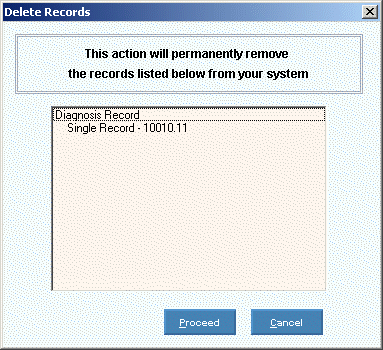Opening Diagnosis Maintenance, click More.
1. Click File Maintenance from the Menu Bar.
2. Click Standard Maintenance.
3. Then click Diagnosis.
Or, use the keyboard
shortcut: [ALT] [m]
[t] [d].
Diagnosis Code Maintenance Window Example:

Creating a new Diagnosis, click More.
Diagnosis Maintenance Prompts Tip: To see more information about a field, click the hyperlink for that field name. |
|
Enter the Diagnosis code assigned to this diagnosis. You can use the International Classification of Diseases (ICD) code or some other code. (9 characters) Tips:
|
|
|
To update the new or changed information click Save or press [ENTER]. Keyboard shortcut: [ALT + s] |
CAUTION: If you forget to click Save, you may lose your changes. |
|
|
You can use Search to view all of the existing Diagnoses. From the Search list you can select a Diagnosis to change or delete. Keyboard shortcut: [ALT + r] |
|
To display an existing Diagnosis, enter the Diagnosis code and click Retrieve or press [ENTER]. Keyboard shortcut: [ALT + t] |
Enter the full description of the Diagnosis. This description prints on the 1500 form. (up to 30 characters) |
|
Enter the abbreviated search description used to search for a diagnosis during Charge Entry. Although not required, you should enter an Alternate/Sort Description. (up to 10 characters) Tip: Some reports use Alternate/Sort Description to find and sort Diagnoses. |
|
Discontinued |
To indicate that the Diagnosis code is active, leave the default No. To indicate that the diagnosis code is no longer used, select Yes for discontinued. Discontinued means that it cannot be used for new charges, but the Diagnosis code isn't deleted because it may still be used on patient and ticket history as well as current patient tickets. Note: By default the Diagnosis Search window does not display discontinued diagnoses. To include discontinued diagnoses, select the Search window option View Discontinued Items, then the discontinued diagnosis code will display in the search list. |
Enter the Private Diagnosis to print on the patient's private statement, if applicable. (up to 9 characters) Note: If Private Diagnosis is left blank, the Alternate/Sort Description will print on private statements. The appropriate Diagnosis Code will always print on insurance claim forms. |
|
Note: Because you can tailor the labels of the nine Form Type fields, the field labels in your software may not match the field names listed below. |
|
Enter the Diagnosis code to print for this Form Type. This Diagnosis code is referred to as the Diagnosis Print code and will print on the appropriate insurance form. The Form Type Diagnosis Print code may be specified by the insurance carrier. (9 characters) Note: To satisfy Medicaid requirements for the HCFA claim form, FPF must print in box 24e and FP must print in box 24h for family planning diagnosis. To accomplish this, you must type FPF as the Medicaid Print code for family planning Diagnosis codes. Tip: To quickly enter the same Diagnosis Print code for each successive Form Type (if applicable) use the copy and paste commands. Keyboard shortcuts: [CTRL +c] = copy and [CTRL + v] = paste |
|
Form Type 2 - 9 |
Enter the Diagnosis code to print for this Form Type. This Diagnosis code is referred to as the Diagnosis Print code and will print on the appropriate insurance form. The Form Type Diagnosis Print code may be specified by the insurance carrier. (9 characters) |
ICD10 |
If the Diagnosis code is in the ICD10 format, check this box. If the Diagnosis code is not in the ICD10 format, leave this box unchecked. Note: It's important that if a Diagnosis code is an ICD10 code that this box is checked. |
Enter the Form Types (enter the Form Type Number) that should not be transmitted electronically when the Diagnosis code is used. Enter the Form Type numbers in sequential order without spaces or commas. (9.0 numeric) |
|
Displays the number of times this Diagnosis code was made by the providers within the practice during the current period. |
|
Displays the number of times this Diagnosis code was made by the providers within the practice during the current year. |
|
Editing an existing Diagnosis, click More.
![]() CAUTION! If you
forget to click Save, you may lose your changes.
CAUTION! If you
forget to click Save, you may lose your changes.
1.
To display the record to be changed, enter the Diagnosis
code and click Retrieve
![]() or press [ENTER].
or press [ENTER].
Keyboard shortcut: [ALT
+ t]
Tip: If you do not know the Diagnosis
code, you can click Search
![]() to see a list of
Diagnoses.
to see a list of
Diagnoses.
2. To position the pointer to the information that you want to change, press [TAB] or click the field using the mouse.
3. Enter the data changes.
4.
To complete the edit process, click Save
![]() or press [ENTER].
or press [ENTER].
Keyboard shortcut: [ALT
+ s]
Deleting a Diagnosis, click More.
1.
To display the record to be deleted, enter the Diagnosis
code and click Retrieve
![]() or press [ENTER].
or press [ENTER].
Keyboard shortcut: [ALT
+ t]
Tip: If you do not know the Diagnosis code, you can
click Search ![]() to see a list of Diagnosis codes.
to see a list of Diagnosis codes.
2.
Click File from
the Menu
Bar, and then click Delete.
Keyboard shortcut: [ALT]
[f] [d]
3.
At the Delete Records prompt, click the Proceed
button to delete the record
or, click the Cancel button
to escape from the delete routine.
Example:

Note: After you click Proceed,
you will see the following message on the Status
Bar.
![]()